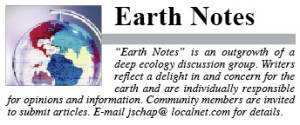Immigration Fuels Huge U.S. Population Growth
By Ken Roy
There is a limit to the number of people our planet can support, known as “carrying capacity.†It refers to the number of people who can be supported  without degrading the physical, social and cultural environment. We are responsible to future generations, and we owe them a chance at a good quality, not quantity, of life.
without degrading the physical, social and cultural environment. We are responsible to future generations, and we owe them a chance at a good quality, not quantity, of life.
We must regain the mindset we had in 1970 when the “father of the environmental movement†and creator of the first Earth Day, Senator Gaylord Nelson, maintained that stabilizing U.S. population growth should be our first priority. The committee that created that first Earth Day was entitled the Committee on Population and the Environment. Congress appointed a blue ribbon commission (the Rockefeller Commission) to study U.S. population growth. The group called for stabilizing our population and declared, “We have looked and have not found any convincing argument for continued population growth.†This commission set a limit of 400,000 immigrants per year. The American people heard the message and in 1972 we achieved replacement level fertility.
Two later presidential commissions, Father Hessburg in 1979 and President Clinton Council in 1993, came out with similar findings.
“But as the environmental movement grew rich and dependent on corporate funding, the central message, of stabilizing our numbers, was lost. Congress, at the behest of business lobbies, quadrupled immigration numbers bringing in new consumers and workers. Between 2000 and 2007, just seven years, the U.S. population grew a whopping 20.2 million. Last year, the Census Bureau estimated that immigration accounts for roughly 80% of our growth.â€
Eight years ago in his book Beyond Earth Day: Fulfilling the Promise, Nelson wrote, “It is a fact that until we address the growing influx of immigrants… the population will continue to grow indefinitely despite the nation’s success at achieving a replacement level birthrate. Never has an issue with such major consequences for this country been so ignored. Never before has there been such a significant failure by the president, Congress, and the political infrastructure to address such an important problem. We are faced with the most important challenge of our time — the challenge of sustainability — and we refuse to confront it. It is the biggest default in our history.â€
He goes on to say, “While federal actions have increased the immigration rate dramatically during the last four decades, any suggestion that the rate be decreased to some previously acceptable level is met with charges of ‘nativism,’ ‘racism’ and the like. Unfortunately, such opposition has silenced much needed discussion of the issue.â€
Resorting to bullying tactics has become the thing to do by the open-borders, unlimited-immigration advocates, and it does, indeed, limit rational, commonsense dialogue on this huge problem we have. This population problem has nothing to do with racism, nativism and the like. It has everything to do with unsustainable numbers adversely affecting the environment for our wellbeing and that of future generations. Immigration must be addressed simply because it is the biggest factor in the increases, roughly 80%. According to the U.S. Census Bureau projections, without immigration, America’s population would increase from 310 million today to 377 million by 2100. At our current high levels of immigration, we are on target to nearly triple our population to 854 million by the end of this century. Is this the kind of country we want to leave for our descendants?
“Let’s not kid ourselves: population makes all the difference in the scale of our environmental problems, and continued population growth undermines ecological sustainability. It will be a huge challenge to create a sustainable United States with 300 million people, but it will probably be impossible to do so with double or triple that number.â€
Sources: Jonette Christian of MSIP (Mainers for a Sensible Immigration Policy); Phillip Cafaro, associate professor of philosophy at Colorado State University U.S. Census Bureau.
Kenneth Roy is a resident of Center Lovell.

